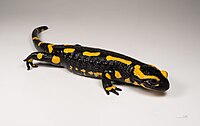
Photo from wikipedia
Research on male courtship behavior of moths has focused on documenting stereotyped sequences for successful copulation. We characterized successful male courtship behavior among 126 virgin mating pairs of Ostrinia nubilalis.… Click to show full abstract
Research on male courtship behavior of moths has focused on documenting stereotyped sequences for successful copulation. We characterized successful male courtship behavior among 126 virgin mating pairs of Ostrinia nubilalis. Using Markov analysis, stereotypy indices, and a novel application of ecological network analysis, we found high variability in these sequences. Fifteen courtship behaviors were described and 96 behavioral transitions were observed, 39 of which occurred only once. The number of courtship bouts ranged from one to ten, the number of behavioral transitions ranged from four to 41, and the number of copulation attempts ranged from one to 29. Only 23% of males used a common, simple behavioral sequence. Females exhibited acceptance or rejection behaviors in 40% of the sequences, but these did not explain the high variability in male courtship sequences. About half of the transitions occurred non-randomly, and stereotypy was low. Network analysis revealed that the courtship sequences started and ended with stereotyped behaviors and the high variability occurred in the middle of the sequences. Whole system analysis showed that the courtship sequences were more variable than for optimal transfer of information. Overall, these results suggest that the sequence of behaviors may be less important than the occurrence of certain behavioral elements for successful mating.
Journal Title: Journal of Ethology
Year Published: 2017
Link to full text (if available)
Share on Social Media: Sign Up to like & get
recommendations!